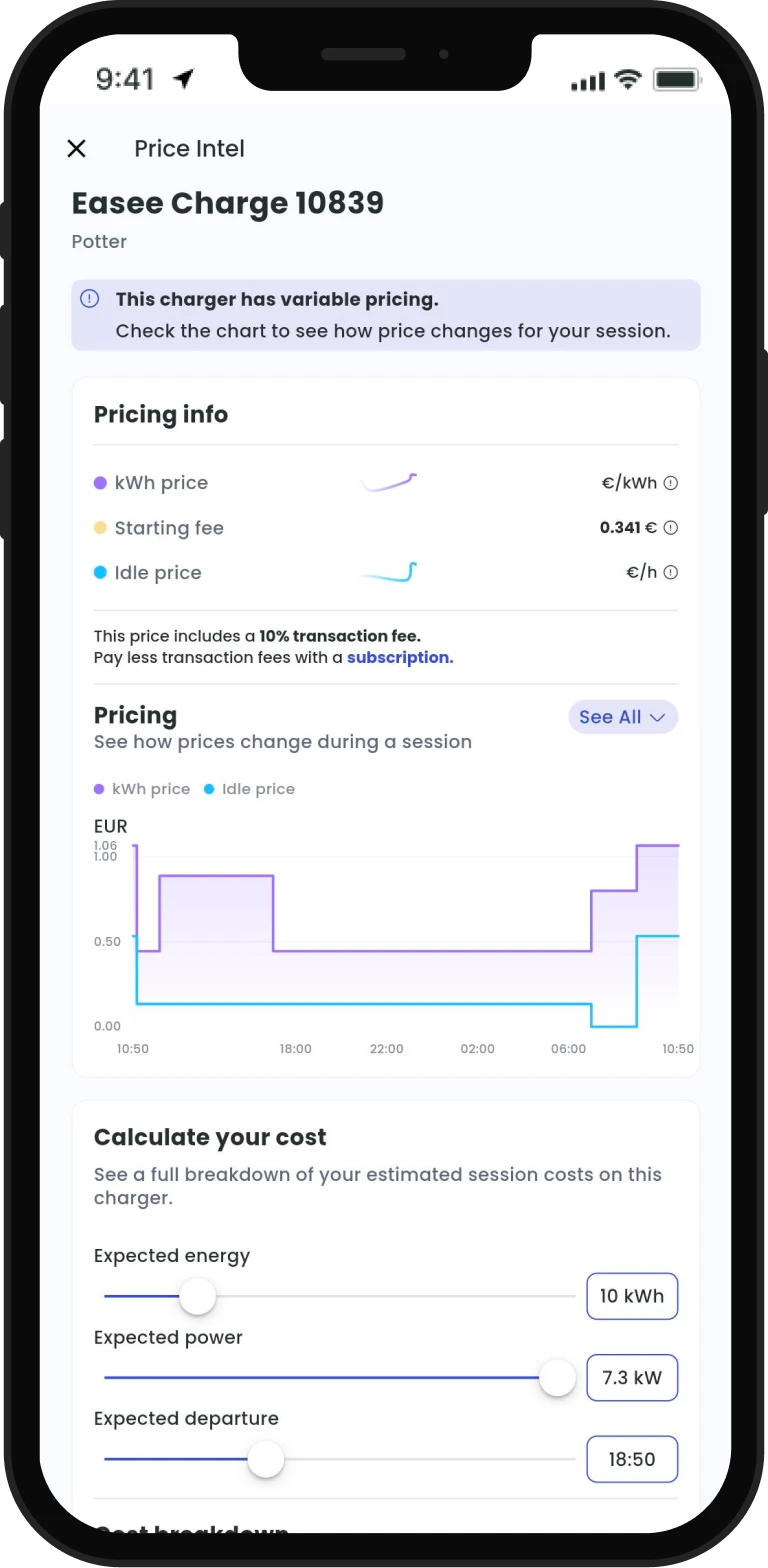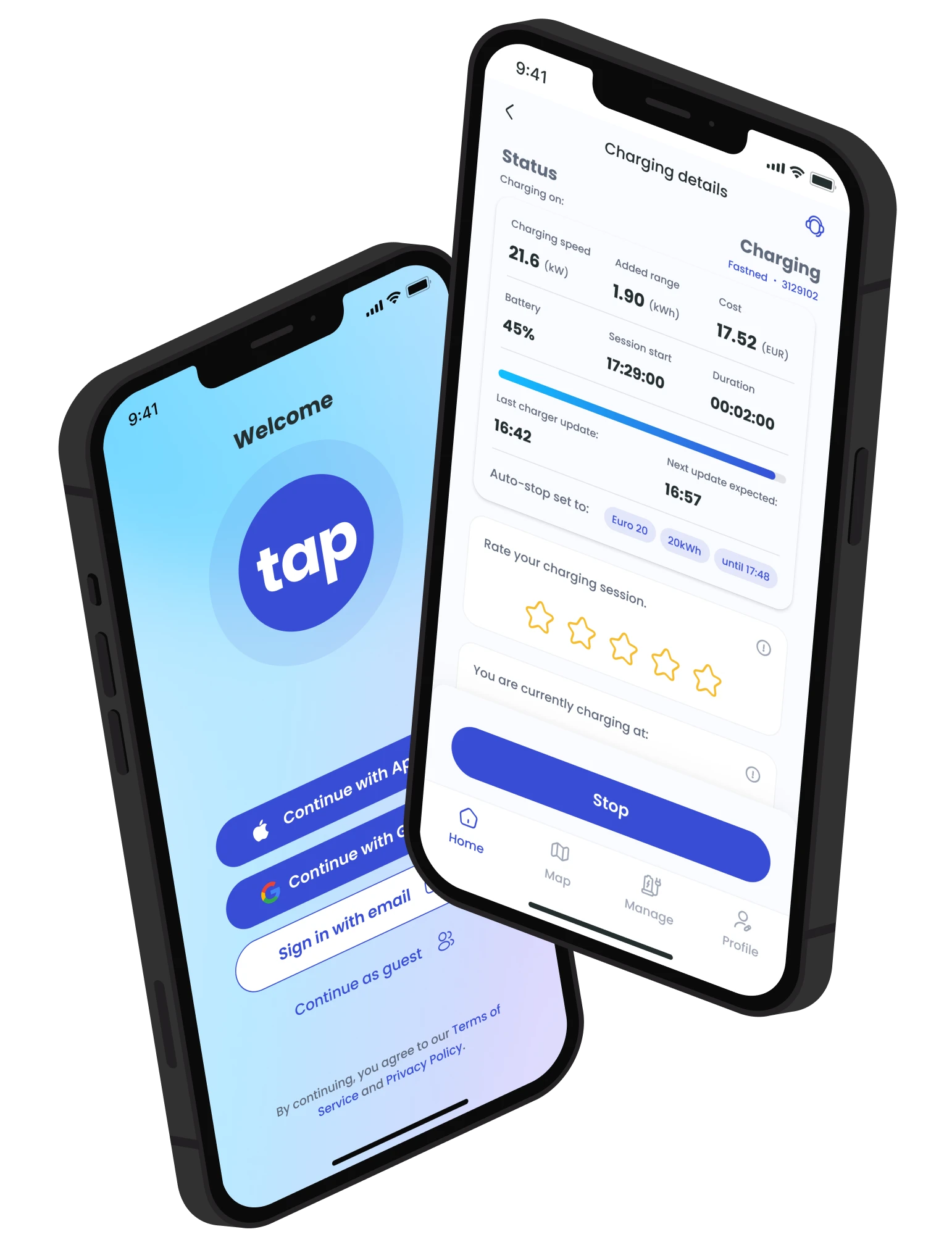Summary - how much does charging an electric car cost on the public network?
- In most neighbourhoods, drivers could pay up to €0,26/kWh more to use an equivalent charger under 23 kW within walking distance. We found big outliers where some privately managed chargers outside of municipal tenders charge drivers up to €2,62/kWh.
- Hilversum (postcode 1202) offers the cheapest prices on average €0,25/kWh for chargers under 23 kW.
- Bijlmer Centrum (postcode 1102) offer the cheapest chargers for chargers over 50 kW.
- Drivers may save more by comparing charger prices often to find the best price.
Want to know what this means for you? See how Tap helps you save at the end of the post.
We’ve analysed the average price per kWh on Dutch chargers. To make matters more interesting, we then looked at the differences in kWh prices on equivalent chargers in the same neighbourhood. We defined the price spread as the difference between the cheapest and most expensive price within an area.
We found big price differences between chargers with the same power within neighbourhoods. So by comparing prices in your neighbourhood, you could save hundreds per year by using a charger with the cheapest price.
These Dutch neighbourhoods have the cheapest AC chargers under 23 kW on based on average price per kWh. However, we found that on some chargers you could pay up to €0,10/kWh more for an equivalent charger within walking distance.
Postcode
Average price per kWh (incl. VAT)
Price difference between equivalent chargers
1. Hilversum (Noord-Holland)
1202
€0,254
None
2. Dieren (Gelderland)
6956
€0,268
€0,048
3. Beusichem (Gelderland)
4112
€0,294
None
4. Varik en Ophemert (Gelderland)
4064
€0,294
None
5. Varik en Opemert (Gelderland)
4063
€0,294
None
6. Maurik (Gelderland)
4024
€0,294
None
7. Hummelo en Keppel (Gelderland)
6996
€0,294
None
8. Ijsselmuiden en Grafhorst (Overijssel)
8277
€0,294
None
9. Dreumel (Gelderland)
6621
€0,294
€0,007
10. Rozendaal (Gelderland)
6891
€0,303
€0,110
So which neighbourhoods consistently have the cheapest AC chargers?
The 3 cheapest neighbourhoods to charge under 23 kW are:
- Hilversum (postcode 1202) at an average €0,25/kWh of with no price difference between equivalent chargers.
- Dieren (postcode 6956) at an average €0,27/kWh with up to €0,04/kWh price difference between equivalent chargers.
- Beusichem (postcode 4112) at an average €0,29/kWh and with no price difference between equivalent chargers.
These are the neighbourhoods that have the lowest average price per kWh and smallest price spread.
Where can drivers pay a fair price for an AC charger under 23 kW?
The good news for drivers is that our research identified 241 neighbourhoods where chargers under 23 kW are priced below the Dutch average of €0,44/kWh.
Among these, 106 neighbourhoods had no price differences between equivalent chargers, while in the remaining 135, drivers could pay up to €0,16/kWh more to charge at equivalent chargers within a short distance.
Which neighbourhoods have the cheapest DC chargers?
The majority of fast chargers over 50 kW have a price spread within €0,08/kWh.
The 3 cheapest neighbourhoods to charge over 50 kW are:
- Bijlmer Centrum (postcode 1102) at an average €0,45/kWh and no price difference between equivalent chargers.
- Schijndel (postcode 5481) at an average €0,67/kWh with no price difference between equivalent chargers.
- Eijsden (postcode 6245) at an average €0,69/kWh with no price difference between equivalent chargers.
What to look out for?
We’ve found some outlier prices where you can pay up to €2,62/kWh for a charger under 23 kW.
That’s why it’s important to have a good charging app like Tap where you can see transparent charger prices before you start charging.

With Price Intel in the Tap app you can:
- See a full price information including kWh price, idle price, hourly price and starting cost.
- See immediately on each charger whether there’s a charger nearby with better pricing.
- See how prices change during a session for chargers with variable pricing.
- Calculate your estimated session costs on any charger in the app before you charge.
- Compare which charge card has the best price on many chargers in the app. Pricing with the Tap Roamer subscription is usually the cheapest option, and we’re upfront when it’s not – that’s how transparency works!
Resources and expertise: the methodology behind our data
Our experts fact checked and last updated this research on 29 March 2024.
Sources:
The data was taken from live tariff data of public chargers on 29 March 2024 incl. VAT.
Details:
- Only tariffs with solely a kWh were analysed for comparison. Over 96.000 outlets were included in our research.
- Tariffs were grouped based on the power range of the chargers, under 23 kW and over 50 kW.
- Tariffs were grouped based on the first 4 digits of their location’s post code, which in the Netherlands represents approximately one neighbourhood. In dense urban areas this certainly represents a walkable area; in a less dense area, this would more likely be driving distance.
- 2020 neighbourhoods were included in our research that have a minimum of 4 outlets.
- Some of these neighbourhoods may have semi-public chargers that are limited to certain residents, employees or groups of drivers. This is dependent on the data shared by CPOs.
- All pricing analysed is CPO pricing, meaning the research did not consider MSP business models.
